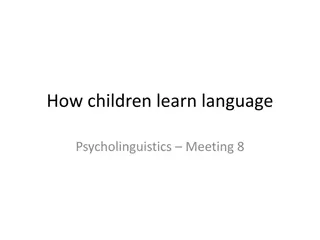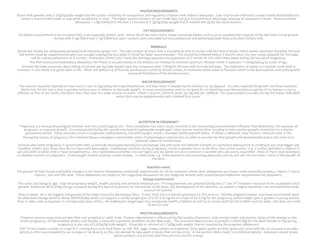Understanding Physical Growth and Development in Infants
Human development during infancy involves significant physical, cognitive, emotional, and social growth. This module explores the physical growth patterns, brain development, motor skills, perceptual abilities, and nutritional needs of infants. It also discusses the impact of breastfeeding, sleep concerns, vaccination debates, and consequences of failure to thrive. Rapid changes in weight, length, and brain size occur during the first two years, highlighting the importance of early childhood development.
Download Presentation

Please find below an Image/Link to download the presentation.
The content on the website is provided AS IS for your information and personal use only. It may not be sold, licensed, or shared on other websites without obtaining consent from the author. Download presentation by click this link. If you encounter any issues during the download, it is possible that the publisher has removed the file from their server.
E N D
Presentation Transcript
Lifespan Development Module 4; Infancy
Module Learning Outcomes Describe human development during infancy 4.1 Describe physical growth and development in infants and toddlers 4.2 Explain cognitive development in infants and toddlers 4.3 Explain emotional and social development during infancy
Learning Outcomes: Physical Growth & Development in Infants 4.1 Describe physical growth and development in infants and toddlers 4.1.1: Summarize overall physical growth patterns during infancy 4.1.2: Describe the growth of the brain during infancy 4.1.3 Explain gross and fine motor skills in infants 4.1.4 Explain newborn perceptual abilities 4.1.5 Explain the merits of breastfeeding 4.1.6 Discuss the importance of nutrition to early physical growth, including nutritional concerns for infants and toddlers such as marasmus and kwashiorkor 4.1.7 Describe sleep concerns for infants 4.1.8 Explain the vaccination debate and its consequences
Overall Physical Growth Birth weight & length Normal weight range ~ 5lb 8 oz to 8lb 13oz Normal length range ~ 19.5 inches Babies lose approx. 5% of body weight in first few days Normal adjustment to life outside womb- waste elimination, feeding Physical proportions Head-to-body ratio: head comprises 25% of total length at birth Percentiles: 1-100 Failure to thrive: a child born in normal ranges falls below 20thpercentile Detection is key to medical intervention Photo credit: modification of work by Kerry Ceszyk
Physical growth, continued Weight: At 4 months old, weight typically doubles At one year, weight has tripled By age 2, weight has quadrupled. Length: Average length at 12 months ~28.5-30.5 inches Average length at 24 months ~33.2-35.4 inches (CDC, 2010). Children experience rapid physical changes through infancy and early childhood.
Brain Growth- The First Two Years Growth Physical size of brain increases At birth, brain is 25% adult weight At 2-years-old, 75% Neural development Most neurons are present at birth, not fully developed Transient exuberance: period of prolific dendritic connections Myelination: myelin sheath (fatty cells) protects axons, speeds neural transmissions Pruning: unused connections eliminated in favor of much-used connections Prefrontal cortex Least-developed portion of brain at birth; substantial growth During transient exuberance, a single neuron may have thousands of dendrites
Motor Development Reflexes are inborn Some are necessary for survival Rooting reflex, breathing, sucking reflex Some signify health, development Moro reflex, stepping reflex, palmar grasp Motor development is orderly Follows cephalocaudal (head-down) proximodistal (center-out) principles Gross Motor Skills Large muscle groups Fine Motor Skills Small, coordinated muscle movements Pinching, grasping This baby is working on his pincer grasp.
Motor & Sensory Development Sensation & Perception Sensation: interaction with sensory receptors Perception: interpreting information sensed Sensory Development Sight- least developed at birth Newborns see ~8-16 inches in front of them Preference for faces, unusual, interesting, exciting images Hearing: most developed at birth In the womb, babies know the sound of mother s voice Touch/pain Physiological reactions indicate sensation of pain- circumcision Touch- necessary and comforting Taste/smell Ability to distinguish flavors: sweet, salty, sour, bitter (prefer sweet tastes) Identify mother s smell easily
Nutrition Breastfeeding- breast is best Colostrum: liquid gold, nutrient-dense, first days of life Breastmilk has iron, fats, proteins, for proper development Alternatives to breastfeeding Formula feeding may be necessary in various conditions (mother doesn t produce enough milk, adoptive or two- father family, mother has communicable disease, etc.) Introducing solid foods Start simple: one at a time is best, spaced days apart to ID allergies Malnutrition & clean water access Kwashiorkor: displaced child s disease - lack of sufficient nutrition Marasmus: starvation from lack of calories, protein Milk anemia: Lack of iron from drinking cow s milk in place of more nutritive foods Clean water makes clean formula Breastmilk changes in composition with a newborn s development and needs.
Sleep & Health Infant sleep requirements From 0-2 years, average 12.8 hrs/day Newborns sleep 14-17 hrs SIDS: many risk factors, many unknowns Sudden Unexpected Infant Deaths (SUID): some identified causes Back to Sleep Back-sleeping recommended for every sleep No soft bedding, blankets, potential hazards Co-sleeping Benefit of skin-to-skin contact Risk of child suffocation, increased risk w/ parental drug/alcohol use Sleep schedules Nighttime waking is common Many infants sleep 6 hrs during night by 6 months Not doing so does not indicate a serious problem, but individual differences
Vaccinations Immunizations: the debate Personal beliefs, opt-out programs, religious beliefs Need for community protection, prevent resurgence of diseases Herd immunity 90%+ of population is vaccinated, population is protected Approx. 1 in 14 children isn t vaccinated Outbreaks More frequent as fewer opt to vaccinate Children in communities throughout the world can benefit from immunizations and herd immunity.
Practice Question 1 Which nutrient found in breast milk is essential to myelination? A. Calcium B. Iron C. Fat D. Proteins
Class Activity: Vaccinations Break into small groups to discuss vaccinations and public health. What is your opinion on vaccinations? Should they be mandatory? Should individuals have the opt-out choice? Write a resource paper, citing scholarly sources, supporting your arguments.
Learning Outcomes: Cognitive Development in Infants & Toddlers 4.2 Explain cognitive development in infants and toddlers 4.2.1 Describe each of Piaget's theories and stages of sensorimotor intelligence 4.1.2: Describe the growth of the brain during infancy 4.2.2 Explain learning and memory abilities in infants and toddlers 4.2.3 Describe stages of language development during infancy 4.2.4 Compare theories of language development in toddlers 4.2.5 Explain the procedure, results, and implications of Hamlin and Wynn's research on moral reasoning in infants
Cognitive Development: Piaget & Sensorimotor Intelligence Schemas: mental representations used to understand the world Assimilation: modification of new information to fit into our existing schemas Accommodation: reorganizing what we know to fit new information Six stages of sensorimotor intelligence Stage 1- Reflexes (Birth- 6 weeks) Stage 2- Primary Circular Reactions (6 weeks- 4 mo.) Stage 3- Secondary Circular Reactions (4-8 mo.) Stage 4- Coordination of Secondary Circular Reactions (8-12 mo.) Stage 5- Tertiary Circular Reactions (12-18 mo.) Stage 6- Mental Representation (18-24 mo.) Object Permanence Knowledge something exists when out of sight (understanding ~8 mos/ mastery ~12-24 mos)
Learning & Memory Abilities in Infants Piaget underestimated infant memory ability Lacking in language to express memory Experiments: preferential looking Infantile amnesia Infants and toddlers form memories, remember them weeks, months later Lack of memory years later Encoding/ retrieval failures Older children, adults use linguistic retrieval methods Misalignment between encoding and new memory organization
Language Development Phonemes are basic units of speech, which make morphemes, the smallest meaningful units of speech When a child starts vocalizing, they produce all phonemes With specialization, only native phonemes are easy to reproduce Stages of language development: Stage 1: Reflexive Communication Stage 2: Reflexive communication; interest in others Stage 3: Intentional communication Stage 4: First words Stage 5: Simple sentences (two words) Stage 6: Sentences of three or more words Stage 7: Complex sentences; has conversations This 8-month old baby boy is likely babbling and gesturing to communicate
Language Development, cont. Intentional vocalizations: gurgling, cooing, learn conversational cadences Babbling, gesturing: syllable repetition, gesturing, sign language Babies understand more language than they can produce Holophrasic speech: partial words convey thoughts People close to the child often interpret correctly Underextension: a word may only be used for one specific think Example: Mommy is my mother, so I shout for her in the grocery store when I am lost Overextension is more common- generalizing First words, cultural influences Nouns, verbs, relationships- parts of speech vary by language & culture Vocabulary growth spurt/ naming explosion: rapid vocabulary expansion Many new words are nouns; child can name things around them & in the world Two-word sentences, telegraphic speech: Lacks complete grammar, yet conveys meaning (like text messages) Child-directed speech: captures children s attention, articulates sounds
Theories of Language Development Nativism- Noam Chomsky Language Acquisition Device- innate ability to learn language, understand conventions and syntax Children learn language through exposure, can learn any language Critical periods- during these times learning is most important Behaviorism- B.F. Skinner Language is taught through reinforcement Social Pragmatics- Tomasello & Hermann Communication develops from need to communicate, join social world All have components of truth and help explain language learning
Moral Reasoning in Infants Kohllberg Methodology relies on asking questions to determine moral justification Infants & toddlers can t communicate this with limited vocabulary Hamlin & Wynn devised experiments to test babies morality Hamlin & Wynn experiments: the bottom line Children refer prosocial behavior Prefer others like themselves Do children have just world belief and revenge motives? How do we know what this little one is thinking? Perhaps preferential looking or reaching can lend insight into infant morality.
Practice Question 2 Why is the stage of rapid vocabulary growth in toddlerhood often called the naming explosion? A. The child learns mostly people s names in his/her expanding vocabulary. B. Words the child adds to their repertoire are mostly nouns: people, places, and things. C. Pronouns are an important part of vocabulary growth, as children learn how to properly refer to other people. D. The child usually enters pre-school programs at this age and revels in reciting names of classmates.
Class Activity: Earliest memories Childhood memories are ephemeral, but some have lasting impact. Think of your earliest childhood memory and try to describe it in as much detail as possible. Note the retrieval cues you used and recall anything you can about your surroundings at the time the memory occurred. Share your memories in small groups and discuss any commonalities between your earliest memories.
Learning Outcomes: Emotional & Social Development During Infancy 4.3 Explain emotional and social development during infancy 4.3.1 Describe self-awareness, stranger wariness, and separation anxiety 4.3.2 Contrast styles of attachment 4.3.3 Describe temperament and the goodness-of-fit model 4.3.4 Use Erikson s theory to characterize psychosocial development during infancy
Emotional Development Attraction & withdrawal Social smiling- appears ~2 months, laughter at 3-5 months Displeasure- frustration is normal, sadness can indicate withdrawal Stranger wariness- appears ~6-15 months Indicator of memory- familiar and unfamiliar Separation anxiety Shows cognitive development: where has my caregiver gone? Peaks around 8-10 months, declines later w/ healthy attachment Emotional regulation Co-regulation: parents help manage amount of stimuli, soothe and comfort A parent may help this child regulate his/her emotions by soothing the child or removing extra stimulus.
Self-awareness Self-awareness: I, me, my, etc. Develops around 15-24 months Understanding of self as an object Rouge test or mirror test: does the baby touch their own nose or the mirror? Rochat s stages Differentiation: self vs. non-self awareness (from birth) Situation: Imitation, reaching for objects away from self (by 2 months) Identification: Self-referential language, pass rogue test (by 2 years) (Later stages:) Permanence: One s sense of self persists through time & space Self-awareness/ meta-self-awareness: Third-person perspective
Attachment Emotional needs vs. physical needs- Harlow s monkey test Comfort over sustenance Ainsworth s strange situation test- tested attachment styles w/ reactions Four main types of attachment: Secure (~65% of babies): parent serves as secure base of exploration Insecure- avoidant: toddler reacts to parent like a stranger; unresponsive to parent, slow to show positive feelings Insecure- resistant/ambivalent: clings to parent when they leave, reject affectionate attempts on caregiver return Does not explore the new environment Disorganized Lease secure attachment; often unpredictable parental behavior, may be from abuse Child has not learned emotional regulation from this model
Psychosocial Development Temperament: Chess & Thomas- 9 dimensions Activity level Rhythmicity or Regularity Approach-Withdrawal Adaptability Responsiveness Reaction Intensity Mood Quality Distractibility Persistence & Attention Span From these dimensions, 4 main categories: Easy babies (40%): overall positive disposition Slow-to-warm (15%): relatively calm, slow to adapt, withdraw from new situations difficult babies (10%): negative moods, slow to adapt to new situations Undifferentiated (35%): combination/variety of dispositional factors Goodness-of-fit model Children s adjustment largely depends on how well their environment is suited to meet their needs Parenting/communication style matches
Eriksons stages- Infants & Toddlers Trust vs. mistrust Resolution: Learning the world is a safe place Unresolved: The world is an untrustworthy or dangerous place Autonomy vs. shame & doubt Resolution: Taking initiative and trying to do things one s self is desirable Unresolved: One s autonomy is thwarted and discouraged. The child learns to doubt their instincts and feel shame at taking initiative Discovery and experimentation are vital parts of learning autonomy
Practice Question 3 Ainsworth s Strange Situation test was designed to test what construct? A. Self- awareness B. Moral development C. Object permanence D. Attachment style
Practice Question 4 Which of the following statements regarding temperament is TRUE? A. An undifferentiated temperament is fairly common, and means a child does not neatly fit into one category. B. Undifferentiated temperament means a child s temperament is disorganized and likely stems from abusive parental relationships. C. An easy baby never displays negative emotion. D. A slow-to-warm baby becomes an easy baby under the right conditions of nurturing and attachment.
Quick Review What are Piaget's theories and stages of sensorimotor intelligence? How does the brain grow during infancy? What learning and memory abilities do infants and toddlers display? How does language develop in stages during infancy? What are the major theories of language development in toddlers, and how do they compare and contrast? How did Hamlin and Wynn conduct their research on moral reasoning in infants, what were their results, and what did their research reveal? What role do self-awareness, stranger wariness, and separation anxiety in infancy? What styles of attachment did Ainsworth describe and test, and how do they compare? How do a child s temperament and the goodness-of-fit model for parenting relate? How did Erikson characterize psychosocial development during infancy?
Quick Review - continued What are Piaget's theories and stages of sensorimotor intelligence? How does the brain grow during infancy? What learning and memory abilities do infants and toddlers display? How does language develop in stages during infancy? What are the major theories of language development in toddlers, and how do they compare and contrast? How did Hamlin and Wynn conduct their research on moral reasoning in infants, what were their results, and what did their research reveal? What role do self-awareness, stranger wariness, and separation anxiety in infancy? What styles of attachment did Ainsworth describe and test, and how do they compare? How do a child s temperament and the goodness-of-fit model for parenting relate? How did Erikson characterize psychosocial development during infancy?























